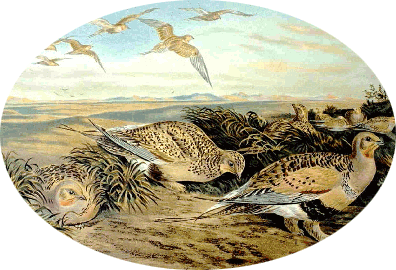| Kingdom: Animalia Phylum: Chordata Class: Aves (Birds) Order: Pteroclidiformes Family: Pteroclidae | |
Identification: Pallas's Sandgrouse has buff plumage, barred above, a black belly patch and pale underwings. The male has a grey head and breast, orange face and grey breast band. The female lacks the breast band, has more barring on the upperparts and is duller. The black belly and pale underwing distinguish this species from the related Tibetan Sandgrouse. This sandgrouse has a small, pigeon-like head and neck, but sturdy compact body. It has long pointed wings and tail and a fast direct flight. Flocks fly to watering holes at dawn and dusk. The legs and toes are feathered. Distribution: This species breeds across middle latitudes of central Asia on dry steppes, arid plains and similar habitats. It is a partial migrant, especially from the northern parts of its range in Kazakhstan and Mongolia, but the extent and distance of the southerly winter movement depends on the amount of snowfall. Breeding: Its nest is a ground scrape into which 2-3 greenish eggs with cryptic markings are laid. Habits: Pallas's Sandgrouse occasionally erupts from its regular breeding and wintering range across Europe as far west as Great Britain, where it has bred, and Ireland. The reasons for these remarkable movements are not fully understood, but they have become less frequent, probably due to contraction of the western Siberian range as the steppes become more agricultural. |
|
 birding.in
birding.in
| Birds | Bird Diagram | Ornithology | Indian Sites | Bird Watching | Migration | North India | Birds of India | Haryana |
All rights reserved. Copyright © 2005-2013 Birds and birding in India. Disclaimer
website: Free Java Guide & Tutorials
